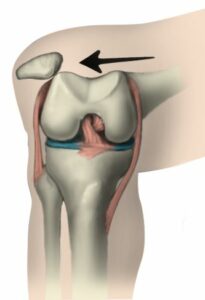Patellar instability is a condition that can cause pain and inflammation in the knee. In most cases, it’s caused by overuse or positional abnormalities. However, there are also a few genetic factors that can lead to the development of this condition. This blog post provides a comprehensive guide on patellar instability, including information on the symptoms, causes, diagnosis, and treatment. We also provide resources for those who want to learn more about this condition.
Contents
What is Patellar Instability?

Patellar instability is a disorder of the knee joint that often affects young athletes. The patella (knee cap) can become unstable, leading to pain and limited movement. Patellar instability is caused by many factors, including genetics, biomechanical abnormalities, and injuries. Treatment options include surgery, physical therapy, and rehabilitation.
Signs of patellar instability include pain when bending or extending the knee, popping or clicking when moving the knee, and difficulty climbing stairs. A person with patellar instability may also experience decreased range of motion and increased lameness. Sometimes, patellar instability is detected during a physical examination or during surgery to repair a knee injury.
One must take into account the whole body when looking at patellar instability. For example, if someone has weak quadriceps muscles, their knee may be more susceptible to patellar instability.
Causes of Patellar Instability
Causes of patellar instability can be classified into two main groups: genetic and acquired.
Some of these causes can be congenital, such as patellar dislocation where the kneecap dislocates from its normal position. Other causes can arise due to an injury or illness.
Genetic factors that can contribute to patellar instability include:
– congenital patella Alta, a condition in which the kneecap is positioned abnormally high in the leg
– patellofemoral syndrome (PFS), also known as runner’s knee, is a common condition characterized by pain and stiffness in the thigh and knee joints due to inflammation of the tendon that connects the thighbone (femur) to the kneecap
– hemophilia A, an inherited bleeding disorder that affects clotting factors in the blood
– dysplasia femoris (DF), a benign condition of increasing incidence in young men in which there is abnormal development of bone growth in and around the femur
– chondromalacia patellae, a condition caused by degeneration of cartilage around the kneecap
Acquired causes of patellar instability can include:
– trauma, such as a fall on the knees or being hit by someone else
– arthritis, which can cause inflammation and damage to the knee joint
– infection, such as osteomyelitis, a bacterial infection of the bone
– meniscal tear, also known as a medial collateral ligament (MCL) tear, is a type of knee injury that results in partial or complete loss of the structure that connects the thighbone (femur) to the kneecap
– chondromalacia patellae, a condition caused by degeneration of cartilage around the kneecap
– patellar tendonitis, an inflammation of the tendons that attach the kneecap to the tibia (shinbone)
– patellar instability secondary to osteoarthritis, the most common type of arthritis
– rheumatoid arthritis, is an autoimmune disease that causes inflammation throughout the body.
Symptoms of Patellar Instability

There are a few key symptoms of patellar instability, and knowing them can help you get the most accurate diagnosis. Here are some of the most common signs:
Pain when the knee is moved from side to side or front to back
One of the most common signs of patellar instability is pain when the knee is moved from side to side or front to back. This is often due to a loose connection between the patella (the kneecap) and the tibia (the shinbone). This can lead to instability of the joint, which can cause pain when the knee is moved. This pain also makes it a difficult task to walk or run.
Proprioception problems
Another common sign of patellar instability is a lack of proprioception or the sense of how your body is positioned in space. This can be due to a loose connection between the patella and the tibia, as well as other joint problems. This can make it difficult to move the knee correctly, resulting in pain and difficulty running or walking.
Joint effusion
A joint effusion is a fluid that accumulates in the joint. This can be caused by several things, including patellar instability. Joint effusions can cause pain and inflammation, as well as decreased range of motion. They can also lead to increased wear on the joint over time, which can eventually cause the joint to break down.
Trouble getting up from a seated or lying position quickly
Sometimes, patellar instability can cause trouble getting up from a seated or lying position quickly. This is because the knee can become unstable when it’s bent too far backward or forwards. This can lead to difficulty standing and walking, as well as pain when trying to get up from a seated or lying position.
Frequent falls or injuries sustained while landing from a jump or running
One of the most common signs of patellar instability is a history of falls or injuries sustained while landing from a jump or running. This is because patellar instability can cause the kneecap to slide forward or backward on the tibia, which can lead to knee pain and injury.
Feeling like your knee “jumps” when you move it
Also, one of the most common signs of patellar instability is a feeling like your knee “jumps” when you move it. This is often due to a lack of synovial fluid in the joint. This fluid helps to cushion the knee and protect it from damage. When there is too little synovial fluid, the knee can feel unstable and bouncy when moved.
Treatment for Patellar Instability

Patellar instability is a condition that causes the kneecap to wobble or vibrate abnormally. This can make it difficult for you to walk, stand, or even sit. Treatment for patellar instability depends on the severity of the condition and may include surgery, physical therapy, or both.
If you experience pain when you try to move your kneecap, consult a doctor as soon as possible. He or she can perform a diagnostic procedure such as an X-ray to rule out any underlying injuries. If the diagnosis is patellar instability, your doctor may recommend one of several treatments.
The most common treatment for patellar instability is surgery. This involves replacing the kneecap with a prosthetic device. Surgery is usually successful in eliminating the symptoms of patellar instability and restoring normal function. However, it is not always necessary and there are risks associated with it, including potential knee injury later on in life.
Physical therapy may also be recommended in cases of mild to moderate patellar instability. This approach focuses on restoring joint stability by teaching you how to properly use your muscles and joints. Physical therapy can help alleviate pain and improve function over time.
Some other treatment methods are:
Medications
Another approach is to use medications to help improve joint stability. These medications can be prescribed by your doctor, and include non-steroidal anti-inflammatory drugs (NSAIDs), such as ibuprofen, and corticosteroids, such as prednisone.
Exercises
Finally, you may also benefit from exercises that help improve joint stability. These exercises can be done in physical therapy or at home. Some examples of these exercises are squats, lunges, and weight-bearing exercises.
Prevention Methods

Patellar instability is a condition that can lead to anterior knee pain, as well as other biomechanical problems. Prevention of patellar instability starts with the following :
Eating a healthy diet that includes lots of protein.
One of the most common causes of patellar instability is a lack of muscle strength and flexibility. To help maintain joint stability, make sure to include plenty of protein in your diet. Aim to consume at least 50 grams per day.
Regularly stretching the quadriceps, hamstring, and calf muscles.
Stretching these muscles can help maintain joint flexibility and protect against patellar instability. Start with gentle stretches and increase the intensity gradually over time. Be sure to stretch regularly throughout the week, not just before or after workouts.
Wearing a supportive knee brace when participating in strenuous activities.
Knee braces can help reduce the chances of anterior knee pain and patellar instability. Make sure to select a brace that fits properly and is comfortable to wear.
Avoiding high-impact activities, like running and jumping.
Avoiding activities that put a lot of stress on the knees can help reduce the chances of developing patellar instability. Instead, focus on activities that are lower-impact and that you can do for long periods.
Wearing shoes that fit well and support the knee.
Wearing shoes that are properly fitted can help reduce the chances of developing patellar instability. Make sure to try on different styles and brands to find the best fit. Also, make sure to wear shoes when you’re not actively using them. This will help keep the shoes from becoming too damaged over time.
Conclusion
Patellar instability is a common condition that can affect the knee. In this article, we will provide a comprehensive guide on what patellar instability is, what causes it, and how to treat it.
Patellar instability is a condition that can cause pain, inflammation, and other issues in the knee. If you are experiencing any of these symptoms, it is important to get evaluated by a doctor as soon as possible. In this comprehensive guide, we have discussed everything you need to know about patellar instability and the treatment options available. Be sure to bookmark this page so that you can keep up with all the latest information on this topic.
Physical Therapy help patients recover from pain. If you’re experiencing Back pain, Shoulder pain, Knee pain, Neck pain, Elbow pain, Hip pain, or Arthritis pain, a physical therapist at MantraCare can help: Book a physiotherapy session.


